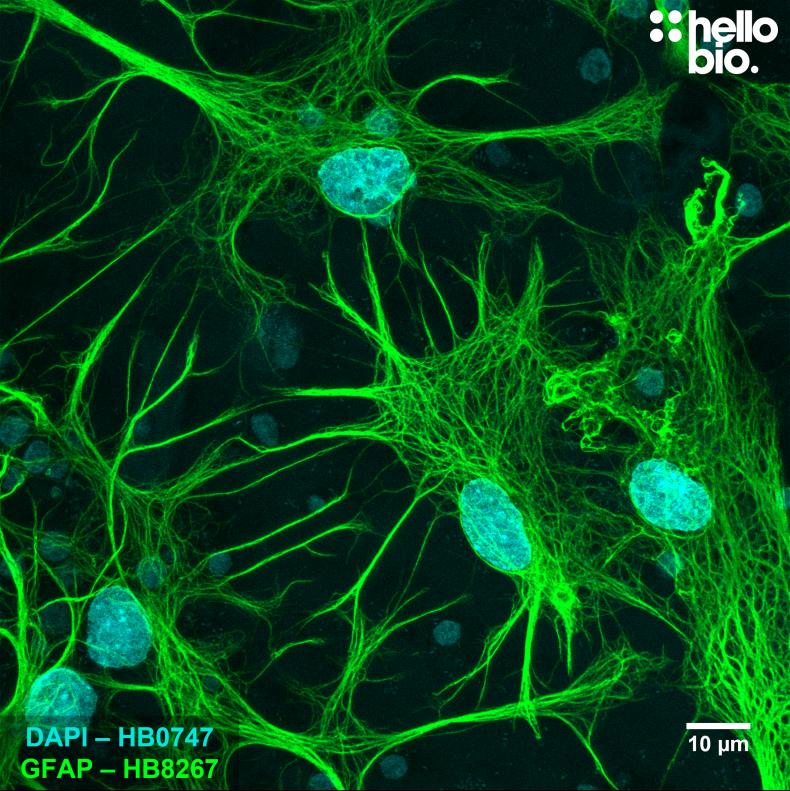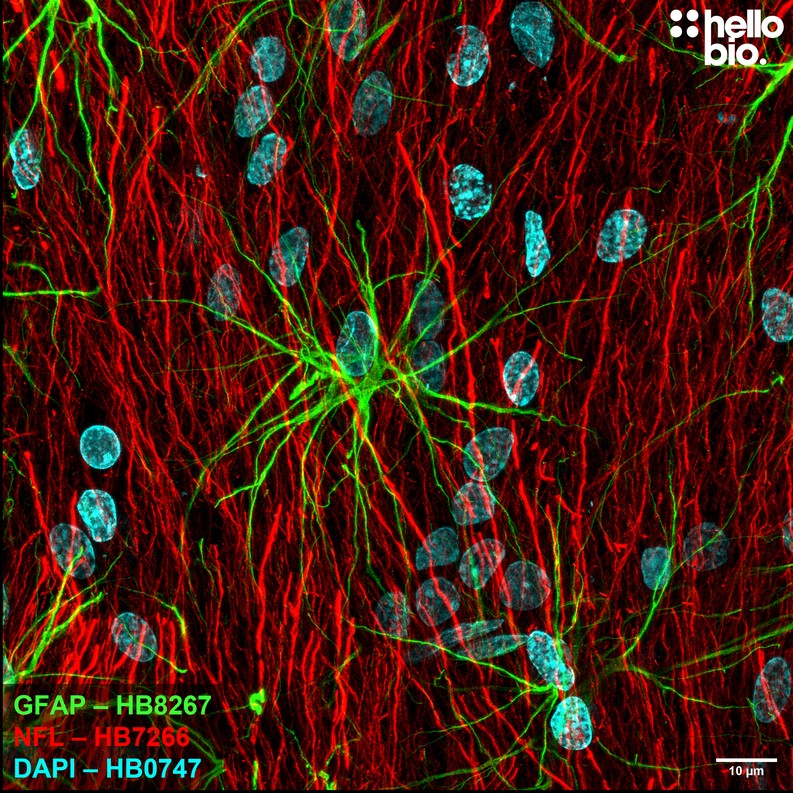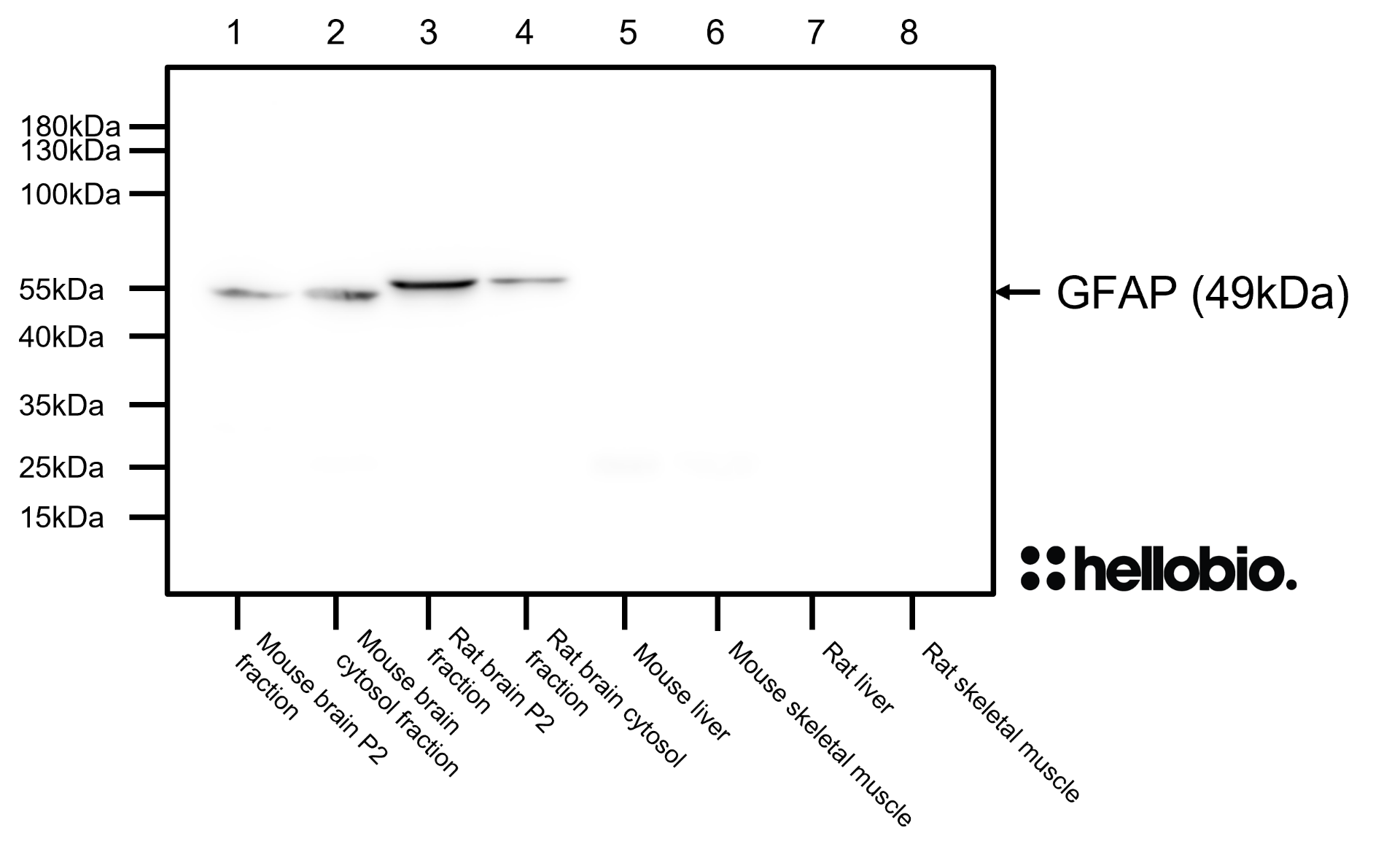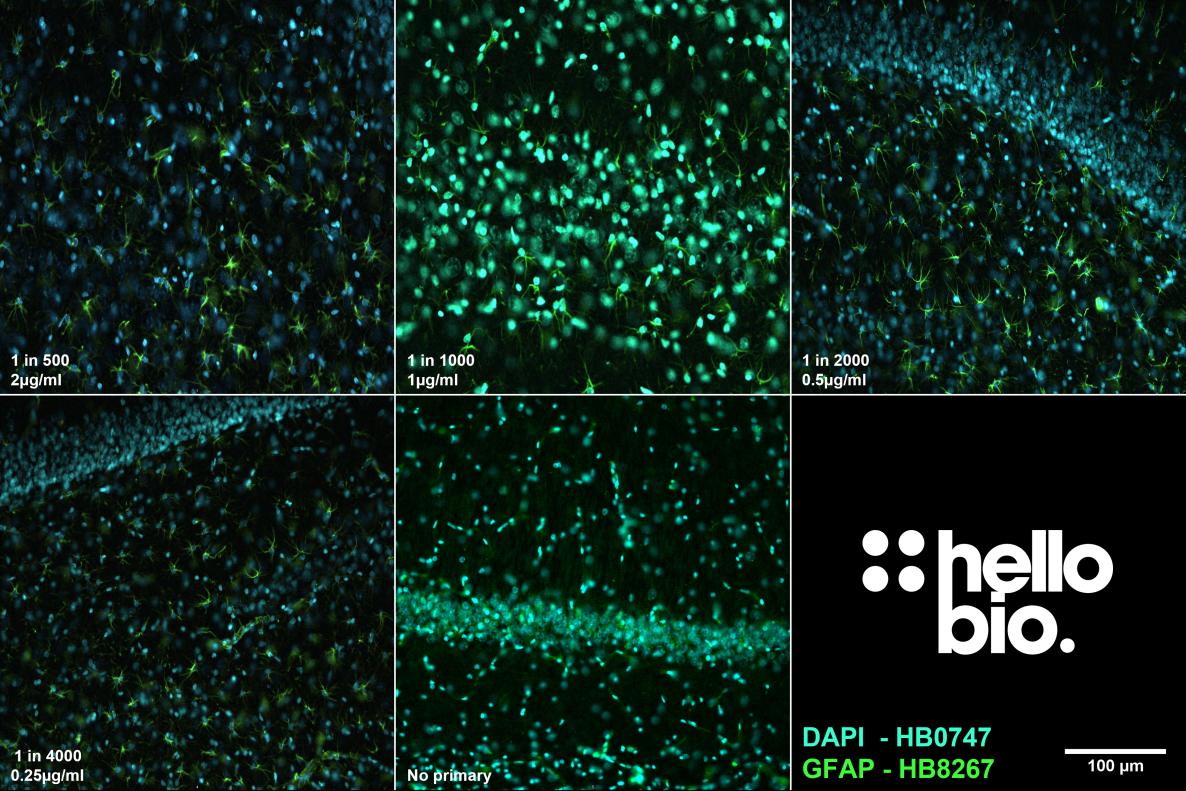![]()
|
Figure 2. GFAP and Vimentin expression in a rat cultured neuron preparation visualised using HB8267 and an anti-Vimentin antibody. GFAP and Vimentin are both expressed in glial cells and can be seen to express at different levels in individual cells creating a colour gradient across the cell population. Method: neurones were cultured from PND2 rats following established protocols (Brewer and Torricelli, 2007. Nat Protoc 2, 1490–1498) and fixed with 4% PFA on DIV21. Cells were permeabilised with 0.1% Triton X-100 followed by blocking in 1% BSA, 300mM glycine. HB8267 was incubated overnight (4°C) at a 1:1000 dilution (1µg/ml) with a goat anti-Vimentin antibody being incubated at a 1:500 dilution (2µg/ml). Secondary antibodies (Polyclonal donkey anti-mouse DyLight 488 conjugated, Thermofisher SA5-10166, 1:300 dilution and Polyclonal donkey anti-goat DyLight 594 conjugated, Thermofisher SA5-10088, 1:300 dilution) were incubated for 1 hour at room temperature. For more detail please see our ICC protocol. Images were captured using a Leica SP8 AOBS confocal laser scanning microscope attached to a Leica DMi8 inverted epifluorescence microscope. The image was captured in a tile scan and z-stack (0.49µm spacing) using Lightning adaptive deconvolution and a 63x objective. Lasers used were 405nm (20.0% power, PMT: 712.7V gain), 496nm (1.0% power, HyD: 14.1% gain) and 561nm (1.5% power, HyD: 10% gain). The tile scan was merged using LASX before the stack was flattened using a maximum Z projection in ImageJ (Schindelin et al., 2012. Nat Methods, 9(7), 676–682). |
![]()
|
Figure 1. GFAP expression in a rat cultured neurone preparation visualised using HB8267. GFAP expression in the dense intermediate filament network of glial cells was successfully visualised using HB8267 at a 1:1000 dilution (1µg/ml). Method: neurones were cultured from PND2 rats following established protocols (Brewer and Torricelli, 2007. Nat Protoc 2, 1490–1498) and fixed with 4% PFA on DIV21. Cells were permeabilised with 0.1% Triton X-100 followed by blocking in 1% BSA, 300mM glycine. HB8267 was incubated overnight (4°C) at a 1:1000 dilution (1µg/ml) followed by a one hour incubation with secondary antibody (Polyclonal goat anti-mouse DyLight 488 conjugated, Thermofisher 35503, 1:300 dilution). DAPI (HB0747) was used at 1µg/ml to visualise cell nuclei. For more detail please see our ICC protocol. Images were captured using a Leica SP5-II confocal laser scanning microscope coupled to a Leica DMI 6000 inverted epifluorescence microscope. The image was captured using a 63x objective (2x zoom), 405nm (20.0% power) and 488nm (20.0% power) laser lines in a z-stack (0.335 µm spacing). Deconvolution was carried out using Huygens Essential (Scientific Volume Imagine) followed by the stack being flattened using a maximum Z projection in ImageJ (Schindelin et al., 2012. Nat Methods, 9(7), 676–682). |
![]()
|
Figure 3. GFAP labelled astrocyte in rat brain. HB8267 staining reveals an astrocyte in rat brain tissue surrounded by axonal processes labelled by HB7266 (rabbit monoclonal anti-neurofilament L). Method: Rat brains were dissected and fixed overnight in 4% PFA before then being incubated in 30% sucrose (in PBS) until sunk (approx. 48hrs). A freezing microtome was used to cut 40µm transverse slices before sections were incubated in 1% NaBH4 for 30 minutes followed by 0.05M glycine for 30 minutes. Sections were blocked in 2% BSA, 3% goat serum before incubation overnight in HB8267 (1:1000 dilution, 1µg/ml) and HB7266 (1:2000 dilution, 0.5µg/ml). This was followed by a two hour incubation with secondary antibodies (polyclonal goat anti-rabbit DyLight 594 conjugated, Thermofisher 35561, 1:300 dilution and polyclonal goat anti-mouse Janelia Fluor 525 (HB8455) conjugated (1:300 dilution). DAPI (HB0747) was used at 1µg/ml to visualise cell nuclei. For more detail please see our IHC(IF) protocol . The image was captured using a Leica SP8 AOBS confocal laser scanning microscope attached to a Leica DMi8 inverted epifluorescence microscope. The image was captured using Lightning adaptive deconvolution using a 40x objective and 405nm (21.1% power, PMT: 592V gain), 561nm (0.5% power, HyD: 22.7% gain) and 514nm (1.0% power, HyD: 10.0% gain) lasers. Images were captured as a stack (0.49µm z-spacing) being flattened using a maximum Z projection in ImageJ (Schindelin et al., 2012. Nat Methods, 9(7), 676–682). |
![]()
|
Figure 4. GFAP expression in various tissue lysates and preparations. HB8267 revealed a band of size 49kDa only present in brain derived samples. Method: mouse brain and rat brain membrane (P2) and cytosol fractions were prepared following previous work (Molnar et al., 1993. Neuroscience 53:307-326) from freshly collected adult brains. Other tissue lysates were prepared following established protocols from freshly dissected tissue (see our guide on WB sample preparation). Samples were loaded (20µg / lane) onto a 10% acrylamide gel alongside a protein ladder (Thermofisher, 26617) before being run at 60V for 40 minutes followed by 120V for 90 minutes. Wet transfer to a PVDF membrane was completed in 90 minutes using 400mA. The membrane was blocked for 2hrs in 5% non-fat dry milk before being incubated overnight at 4°C in HB8267 at a 1:1000 dilution (1µg/ml). Following washing the membrane was incubated in secondary antibody (1:10,000 dilution, Polyclonal goat anti-mouse HRP conjugated, Sigma Aldrich A3682) for 2hrs. For more detail please see our Western blotting protocol. Detection was accomplished using Clarity Western ECL substrate (BioRad, 1705061) and a Licor Odyssey Fc imaging system (ECL channel: 10 min exposure, 700nm channel: 2 min exposure). |
![]()
|
Figure 5. The effect of varying HB8267 concentration upon staining in rat hippocampus. HB8267 produced a strong signal to noise ratio at dilutions as low as 1in4000 (250 ng/ml). Method: hippocampi were dissected from rat brains and fixed overnight in 4% PFA before then being incubated in 30% sucrose (in PBS) for another 24hrs. A freezing microtome was used to cut 40µm transverse slices before sections were incubated in 0.05M glycine for 30 minutes. Sections were blocked in 1% BSA, 22.52mg/ml glycine before incubation overnight in varying dilutions of HB8267 ranging from 1:500 (2µg/ml) to 1:4000 (0.25µg/ml) with a no primary step omitting the addition of HB8267 to the incubation buffer. This was followed by a two hour incubation with secondary antibody (Polyclonal goat anti-mouse DyLight 488 conjugated, Thermofisher 35503, 1:300 dilution). DAPI (HB0747) was used at 1µg/ml to visualise cell nuclei. For more detail please see our IHC(IF) protocol. Images were captured using a Leica DM2500 epifluorescence microscope (20x objective) coupled to a Leica DFC7000T colour digital camera with DAPI and I3 filters. Exposure times were as follows:
1:500 – DAPI 10x gain, 11ms exposure, I3 10x gain, 26.9ms exposure
1:1000 – DAPI 10x gain, 18.3ms exposure, I3 10x gain, 18.3ms exposure
1:2000 – DAPI 10x gain, 11.1ms exposure, I3 10x gain, 27.1ms exposure
1:4000 – DAPI 10x gain, 11.1ms exposure, I3 10x gain, 32.5ms exposure
No primary – DAPI: 10.18ms exposure, I3: 112.ms exposure (taken using different microscope: Leica DMI6000B with Photometric-Prime95B camera).
Images were processed in ImageJ (Schindelin et al., 2012. Nat Methods, 9(7), 676–682) using the subtract background (50px rolling ball radius) tool before stacking and montage creation. |






